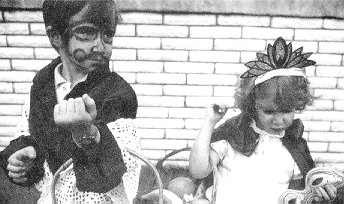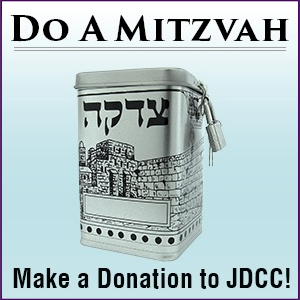 Tuesday, March 2, 1999 – 14 Adar, 5759
Tuesday, March 2, 1999 – 14 Adar, 5759
Read the Megilla, eat, drink, sing, drink, discuss or act out the Purim story, drink, read the Megilla again, drink, give money to the poor, drink, eat, give Mishloach Manot, drink, eat, drink, sing, drink, sleep, wake up with Excedrin Headache #5759.
Purim is the most festive of Jewish holidays, a time of prizes, noisernakers, costumes, and treats. But has the celebration of Purim always been this way? To a large extent, yes! The celebrations usually involve all the above elements, though not necessarily in that order. (Well, fine. Not everyone necessarily wakes up the next morning with a headache.)
During the period of time between the destruction of the First Temple and the building of the Second Temple, the Jews came very close to being annihilated because of the evil scheming of Haman with the king of Persia, Achashverosh (known to the Greeks as Xerxes). Because of the clandestine intervention of God, using Queen Esther and her uncle Mordecai as His messengers, the Jews of Sushan were spared, and instead the nation of Israel was able to avenge itself against its enemies. In order to commemorate this miraculous turn of events, we celebrate Purim on the 1 4th of Adar with feasts, sending gifts of food to our friends and the needy, and with the reading of the Megilla. That’s the whole Megilla thing in a nutshell!
So, where did the name Purim come from? The origin of the word “fur” would seem to be Persian. As written in the Megilla, it means “lot.” Purim is the plural form of “Pur,” and thus, “lots.” The festival is called Purim because of the lots cast by Haman. Seems Haman drew a day out of a hat, and on that day – the 1 4th of Adar – all the Jews in Sushan were to be executed. That whole process is called casting lots. A modern-day version of casting lots would be the lottery.
The four Rabbinic decrees which can be translated as mitzvot for Purim are: Reading of the Megilla, Matanot Le-Evyonim, Mishloach Manot, and Seuda.
Reading of the Megilla
One is required to read or hear the Megilla once in the evening and once on Purim morning. One may read the Megilla all night until dawn and from sunrise ’til sunset. If one has read the Megilla even before sunrise, but at least after dawn, he has fulfilled his obligation to read the Megilla. Both men and women are obliged to hear the Megilla read.
Interestingly, we call it “reading” the Megilla when what we really do is “hear” the Megilla (from the mouth/ hands of the one person reading it). Hearing isn’t really enough and it’s imperative to read the text along with the person chanting the Megilla. In fact, many people customarily read along personally from a “kosher” Megilla (no, it doesn’t chew its cud, it is flawlessly written on parchment) similarly to the one used by the cantor.
The Megilla itself, the story of Esther, is a unique book. It differs entirely in style from the rest of the Bible. It differs, in particular, from the Bible’s prophetic style, which favor open, direct messages, and serious, austere expressions. But The Book of Esther, on the other hand, is riddled with humor – hidden laughter concealed within open laughter. God’s name isn’t even mentioned once in the book, despite the existence of situations which would have been attributed to God’s direct intervention. Also, the Megilla is central to the celebration of Purim – while other Megillot that are related to holidays like Pesach, Sukkot, or Tisha Be-Av, are in no way tied to the existence of their holidays. Purim’s Megilla is the basis and fulcrum of Purim.

There’s a special atmosphere in the synagogue during the Megilla reading. Children of all ages and in various disguises with all kinds of noise-making utensils, sticks, rattles, Purim pistols, and the omnipresent grogger. Every time the name “Haman” is pronounced during the reading, sticks are beaten, rattles are waved, and earsplitting explosive noises come from the Purim pistols, drowning out the reader. The tremendous tumult adds to the general gaiety, and the reader waits until the noise dies down in order to continue reading the Megilla, until the next Haman.”
Matanot L-Evyonim
Gifts for the Poor. One is required to give at least two gifts to two poor people on Purim, in other words, one gift to each. Even a poor person who subsists on charity is required to perform this mitzvah. This obligation can be filled through food or drink or even clothing. The gifts to the poor are given during the day, usually after the reading of the Megilla.
central collection idea: Everyone gives into the hat and it is distributed to those in need. That way, the givers and the receivers remain anonymous, which, by the way, is one of the highest forms of tzedakah. And the money collected and distributed on Purim to the poor is often used to fund Passover, which is right around the corner.
Mishloach Manot
Gifts to One Another. One is required to give a gift which consists of two portions to another person. The food must consist of something edible or drinkable without further cooking and preparation. One may send meat, fish, cooked pastry, wine, and other beverages. These gifts should be sent to as many people as one chooses but they should be sufficient to convey regard for the recipient. If at all possible, these gifts should be sent by messengers, rather than delivered personally, because the Megilla uses the word “mishloach” (sending).

Of course, one can be creative with this and not be limited to sending the standard hamantashen, fruit, and wine. There are many varied (yummy) themes: pasta, crackers, cheese and wine, nuts and raisins, etc . . . Today, many people find the whole custom overwhelming so many friends and people to whom to send gifts. As a solution, many kibbutzim and synagogues host a lottery the week before Purim in which each family randomly selects another family (like a Ugrab bag”) to which they deliver their package on Purim. This saves not only on money, but on inadvertently insulting someone.
Seuda
Feasting and Rejoicing. It is a mitzvah to have a sumptuous meal on Purim, including meat dishes and wine (lots of it!). This feast must be held during the day. The miracle of Purim came though wine. Vashti’s downfall and Haman’s downfall came at a wine feast! There is also a custom of drinking til intoxication, as our Sages tell us, UA person is obligated to drink on Purim until he no longer knows the difference between Cursed is Haman and Blessed is Mordecai.” If one fears that he may be hammed by excessive drinking of wine, or even forget the required blessing one is required to make, drinking excessively is forbidden.
Imagine a commandment that says, Thou shalt pig out verily.” (Whoops! Wrong metaphor!) That’s what the Seuda is all about – eat ’til you drop! But if you think that’s enough, you should attend the Seuda in the Jewish communities of the Middle Eastern countries: There, they start the partying on the eve of Purim right after the reading of the Megilla, and continue until after daybreak. Then, after the morning prayers and Megilla reading, it starts again and lasts until nightfall.. Yemenites often also sing the songs for all of the Jewish holidays to liven up the scene even more. Additionally, in some communities, during the Seuda, actors visit the homes of the wealthy and put on Purim plays which include jokes and parodies. Another activity in some communities is to take a break during the seuda before nightfall and head outside to take part in the “burning of Haman.” (No details available on this particular custom.)
Other Purim Customs
Masking It Up: This is by no means a commandment, but it’s fun! Because the main theme of Purim is that things didn’t turn out as they seemed they would, it became the custom to dress up and mask one’s own identity. Get the connection? Often, people (children and grown-up children) attend the Purim feast dressed up. Some people hold the custom of specifically NOT dressing up in the synagogue for the reading of the Megilla as not to dishonor the sanctity of the event. But others figure – if I’m ever going to show up to synagogue looking silly, this is the best time to do it!

Hamantashen: Like other Jewish holidays, Purim has its own unique culinary treats. The most famous is the hamantashen. This is a triangular piece of dough, usually filled with sweetened poppy seeds or whatever else meets your heart’s delight. Some say that Haman wore a three-cornered hat, and that is why the pocket of dough is triangular. The source of the pastry was apparently poppy seed pockets called “mantashen.” The name was intentionally distorted to “haman sash” -pockets of Haman. Believe it or not, it is a mitzvah to devour Haman with an open mouth. Besides hamantashen, biscuits made of sugar and sweet starch are also enjoyed during Purim.
So, Purim is one fun holiday to participate in! No other holiday, except perhaps Yom Hazamut, Israel Independence Day has quite that much fun and disregard for normal Judaic sanctity. Purim is considered one of the “minors Jewish holidays, like Hanukkah, perhaps because of this fun factor. Then again, you may get so drunk on Purim wackiness you don’t need to see wine or do it up like that for another year!
Information courtesy of the World Zionist Organization, the Department for Jewish Education and Culture in the Diaspora, and Leaming@Torah.




